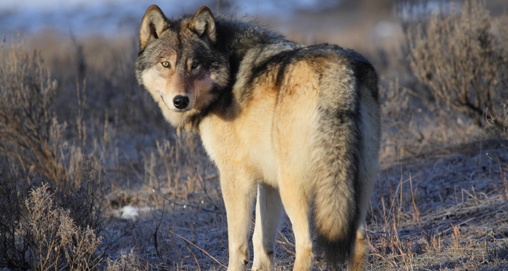
Amid the growth of wolf populations and their devastation of elk herds, business and livestock, and amid lawsuits filed by anti-hunters to prevent wolf management, wildlife managers, hunters, trappers and others are creating new frameworks to ensure there is room on the landscape for predators and prey.
After they were introduced in 1995 and 1996, the story of wolves was about their population growth across the Lower 48. Soon it was also about elk herds crashing, outfitters and other small businesses going under, ranchers losing livestock and wildlife professionals trying to hunt down depredating wolves. Then it was about anti-hunting groups filing lawsuits to stop states from managing wolves even though wolf numbers far surpassed population goals. And all along it’s been about wolves spreading, always going to new areas where these same repercussions might occur all over again.
Now something else is happening. Signs in Idaho, Montana and Wyoming are beginning to change the story line. There’s a plot twist in the saga of the big, bad wolf.
For the on-the-ground details I call wolf researchers, hunters, trappers, ranchers, wildlife biologists and more in areas with wolves.
When I call Montana Fish, Wildlife and Parks’ (FWP) chief of communications Ron Aesheim for answers he barks at me: “I don’t want to see another hunting magazine article saying wolves destroyed all Montana’s elk populations. What you guys never report is that 70 percent of our elk herds are at or above population objectives.”
I bust in and say, “I’ll put that right at the top of the article. But look, what I’m wondering is can you bring elk back in areas with wolves?”
He settles down and says, “We think so. As we get a handle on how to manage wolves we think elk herds, even in areas impacted by wolves, will grow again. We’re looking at possibly making wolf licenses for nonresidents cheaper. We’re now having our first trapping season for wolves. We’re being creative and looking for solutions. In sum, we’re learning and we’re hopeful.”
Next I call Brad Compton, assistant chief of wildlife for Idaho Fish and Game, and get the same reaction: “First of all,” he says, “sure, the elk herds in the Panhandle, Selway, Lolo and Middle Fork are way down, but please also tell your readers we have a lot of elk on public ground on the western side of the state and in the southern mountains.”
I promise to and then explain that last spring I took a horseback ride up the Selway River to hunt black bear. As we rode in my guide kept pointing to vacant campsites and saying each fall these places used to be filled with elk hunters, but now few hunters bother to come anymore. My guide said these days an elk-hunting trip in the area is really just a hike in the backcountry. But then during the bear hunt I saw only one wolf track. And I really wanted to see a wolf. I had a wolf tag and I consider wolves to be an ultimate trophy. In fact, during that bear hunt the five other hunters in camp didn’t see or hear wolves either—even though we were all glassing all day and all had wolf tags.
When I finally saw a few elk—a herd of five bulls with growing antlers—the guide explained that the elk still in the area no longer use the mountaintops much; he said the elk that survived learned to avoid wolves by staying in drainages where they could get away. Up on the open tops it was too easy for wolves to circle the elk and drive them into waiting teeth. The guide said he used to see a lot of wolves back then, especially up high. But he doesn’t see so many anymore.
As all that is anecdotal, I ask Compton, “Do you think the elk in areas with wolves might begin a comeback?”
Compton says, “Sure do. I think we might see an uptick in the elk population in the next five years as hunters and trappers learn to control our wolf populations in the backcountry.”
Compton adds that Idaho’s estimated wolf population actually declined by about 4 percent from 2010 to 2011. He says their estimates found the state’s wolf population peaked with 856 wolves in 2009, fell to 777 in 2010 and dropped to 746 in 2011. When I ask why, he says their studies indicate packs have been getting smaller because of a reduced prey base and because wolves compete with other wolves—packs kill members of rival packs. He also says hunting and trapping seasons and effective depredation controls are helping.
He emphasizes, however, that those wolf numbers are minimum estimates. Accurately counting wolves in the Rocky Mountain wilderness is about as hard as counting alligators in Florida’s swamps. Idaho’s Game and Fish Department even includes a clause in its annual wolf report that says in part: “Our estimates of wolf numbers, pup production, and breeding pairs are conservative. The ‘minimum number of wolves detected’ is the number of wolves observed from the air during winter (December-January) telemetry flights or through other methods, and represents our year-end knowledge regarding wolf packs and groups … .”
Nevertheless, Compton is hopeful they can maintain a better balance of predators and prey. In January when we spoke, Idaho was just beginning its second trapping season for wolves. “Some of the wolf trappers are figuring it out,” he says. “Depending on the unit, they can trap five or perhaps even 10 wolves each year. In the 2011/2012 season trappers got 124 wolves. We’re hoping they’ll do even better this year.”
This makes sense. Years ago I spent a week with a Texas-based Wildlife Services trapper named Glynn Riley. He has been a government trapper in Texas since 1980. He’s a living legend in the circle of people who know predators. When I walked into a rural Texas diner with Glynn a bunch of patrons spontaneously shouted, “Wolf man.” Glynn was bashful when I laughed and said this reminded me of the 1980s sitcom “Cheers” when patrons would shout, “Norm.”
I was there to interview Glynn about coyote control, but soon found he’d trapped the last of the red wolves out of Texas. He’d also spent time in Minnesota training researchers to trap wolves.
He told me, “Trapping wolves is a lot easier than trapping coyotes.” He thought—and proved—that trappers can control a wolf population while hunters often struggle with the highly intelligent canines. He thought it had something to do with the way a wolf travels. “A wolf, well, he’s top dog,” said Glynn. “A wolf walks with a long stride and steps where he likes. A coyote on the other hand, well, he’s naturally afraid of everything. In a natural system a coyote is like a jackal, always on the bottom rung of the predator ladder. Where wolves barge in, coyotes creep in. So wolves are easier to trap—once you learn how.”
I mention this to Compton and he says, “I hope that’s true. It’s been so long since trappers went after wolves in these parts that people have to learn how it’s done all over again.”
When I ask executive director of the Montana Guide and Outfitters Association Mac Minard about this, he says, “Trapping is the single most-useful tool for controlling wolves.
Having trappers out there gives me more hope.”
This past December, Montana held its first wolf-trapping season since wolves were eradicated from the state in the mid-20th century. Before the season more than 2,400 trappers passed the FWP’s six-hour course to become qualified trappers. George Pauley, FWP wildlife management supervisor, says, “There was tremendous demand for the classes.”
No kidding, most of the classes were at capacity.
Meanwhile, Wyoming is just getting started. Wyoming’s wolves were de-listed by the U.S. Fish and Wildlife Service (USFWS) last September. At that time the state got management authority of the estimated 230 wolves then living on land the state manages. Like other states, they have to maintain a minimum wolf population—in their case 100 wolves—to retain management authority of wolves.
Wyoming started its first wolf season on Oct. 1, 2012. The Game and Fish Department reported that from Oct. 1 to Nov. 29, hunters killed 56 wolves—37 in the “Trophy Game Area” region of the state and 19 in the “Predator Zone.” The Wyoming Game and Fish Department established its “Predator Zone” to cover most of central and eastern Wyoming—areas where livestock is almost everywhere. Officially, the state says the “killing of wolves will not be regulated in areas of Wyoming where wolves are designated as a predatory animal.”
That declaration makes animal-rights groups choke on their café lattes, but it’s designed to form a line between where wolves have room to be wolves and areas where conflicts with livestock and pets would be unacceptable to local residents.
With locals finally able to take charge of their wildlife, managing the wolf’s impact on deer and elk populations is starting to look achievable. Minard says, “We’re cautiously optimistic, but we still have a lot of work to do. This last season officials closed two units near Yellowstone because hunters shot a few wolves with tracking collars. I get that they don’t want to lose research animals, but how can hunters manage wolves if officials are going to be that trigger-shy? The elk in those units are in peril. Game officials also need to understand that.”
If this is a turning point—and most involved think it is—then the plot shift is occurring incrementally. This is why the NRA and Safari Club International and groups like the Montana Guide and Outfitters Association are staying involved. They know that if hunters, trappers and wildlife professionals can continue locally managing wolf populations for the good of entire ecosystems then maybe we can have healthy elk populations and wolves.
Imagine that, hearing elk bugling and wolves howling at the same time without getting the sick, nagging feeling in the pit of your stomach that you might be witnessing the beginning of the end of thriving big-game populations in the Rockies? Now that’s a beautiful goal.




































